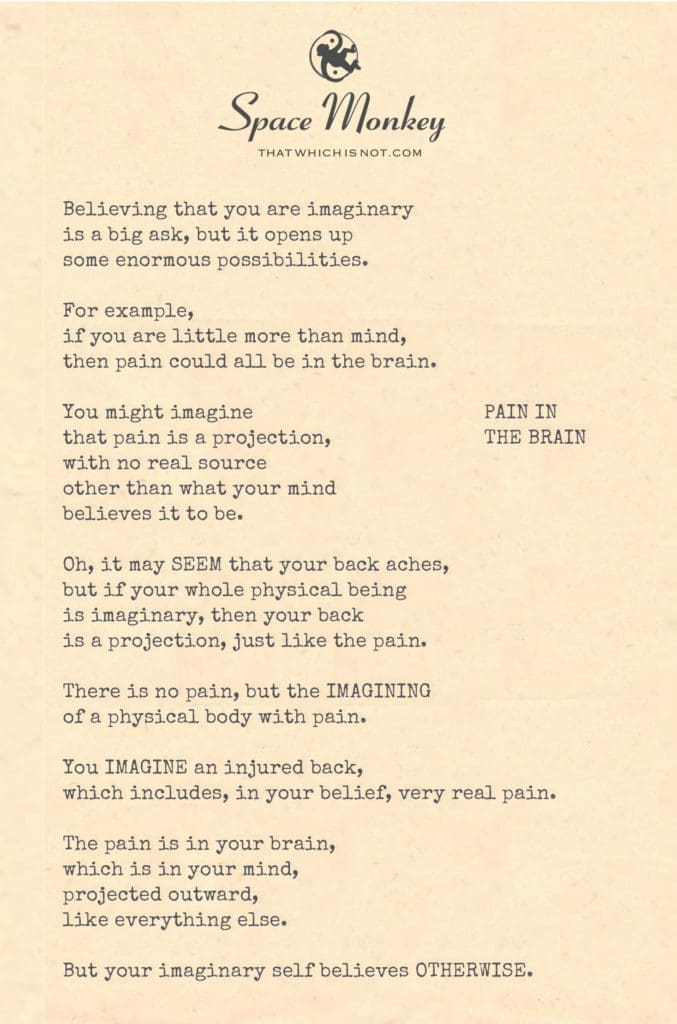
Believing that you are imaginary
is a big ask, but it opens up
some enormous possibilities.
For example,
if you are little more than mind,
then pain could all be in the brain.
You might imagine
that pain is a projection,
with no real source
other than what your mind
believes it to be.
Oh, it may SEEM that your back aches,
but if your whole physical being
is imaginary, then your back
is a projection, just like the pain.
There is no pain, but the IMAGINING
of a physical body with pain.
You IMAGINE an injured back,
which includes, in your belief,
very real pain.
The pain is in your brain,
which is in your mind,
projected outward,
like everything else.
But your imaginary self
believes OTHERWISE.
Trail Wood,
11/30
Space Monkey Reflects: The Imagination of Pain
To consider pain as an imagined experience is to wander into the depths of how we perceive reality itself. If, as the Big Ask suggests, we are little more than projections of consciousness, then pain—like any other sensation—becomes part of that projection, not a fixed experience but an interpretation created by the mind. The backache, the headache, the aching joints—all become parts of an intricate narrative, shaped by belief and perception, woven into the story our mind constructs as “real.”
The notion that pain is “in the brain” prompts us to consider that physical sensations may not arise from an external reality but are instead products of the mind’s elaborate theater. If the body is itself a projection, then pain is just another aspect of this projection. It feels real because our minds perceive it as real, translating electrical signals, memories, and emotions into a tangible experience. The paradox here is that even when pain feels undeniable, its source may lie not in the body but in our interpretation of the body—a construct shaped by expectations, beliefs, and conditioning.
From a Nexistential perspective, this framing of pain as “imagined” doesn’t imply that pain lacks validity; rather, it invites us to view pain as part of the interconnected fabric of existence, woven from thought, sensation, and perception. In this way, pain is as real as any other aspect of the self, yet fluid, shifting, and influenced by the beliefs we hold. When we feel pain, we are feeling an energy that’s interpreted by the brain, but the sensation itself does not exist as a fixed entity. Pain, then, is an experience rather than a fact—a message rather than a permanent state.
This understanding opens the door to an unusual form of freedom: if pain is a construct of the mind, it is possible, in theory, to reshape or even transcend it. To explore pain as a projection is not to diminish its intensity but to recognize the mind’s powerful role in shaping what we feel. It suggests that through shifting awareness, altering beliefs, or embracing new perceptions, we might influence the experience of pain. The projection can be modulated, reshaped, or dissolved, not by ignoring the pain but by addressing the mind’s underlying expectations and beliefs.
Of course, this perspective encounters resistance. Our imaginary selves, bound to a physical experience, insist on the tangibility of pain, the solid reality of an aching back or a throbbing head. The challenge of viewing pain as imaginary lies in the very strength of our attachment to physicality. To perceive ourselves as mere constructs requires a willingness to question not only the nature of pain but the nature of our entire embodied experience. This willingness, however, offers an expanded vision of self, one where pain and pleasure alike become tools for exploration rather than confinements.
Imagining pain as a mental projection doesn’t negate its impact; rather, it shifts the framework. We begin to see pain as a message from the mind—a complex signal shaped by the ways we think, feel, and interpret reality. By redefining pain in this way, we are not erasing it but reinterpreting it, discovering that our response to pain can be as fluid and open-ended as the mind that projects it.
The choice to see pain as a projection is ultimately an invitation to take ownership of experience. It suggests that we are not passive recipients of sensation but active participants in the creation of our reality. The ache may persist, but our interpretation of it, our attachment to it, can transform. In this view, pain becomes less an immutable reality and more a dynamic, evolving part of our imagined self—a signal that asks to be listened to but not necessarily obeyed.
Pain in the Brain reminds us that perception is a powerful force, shaping not only what we feel but how we engage with life’s sensations. By embracing the possibility that pain is an expression of belief, we free ourselves to explore a world where suffering can be examined, redefined, and, in certain ways, transcended. Our imaginary selves may resist, but in this resistance, we find the courage to redefine reality, to live as both creators and experiencers of a world that is as malleable as the mind itself.
Summary
Viewing pain as a projection challenges the idea of it as a fixed, physical experience. By understanding pain as shaped by the mind, we gain insight into the ways perception can influence, reshape, and transcend sensations.
Glossarium
Pain in the Brain: A concept suggesting that pain originates as a projection of the mind rather than a fixed physical reality.
Nexistential: A perspective that embraces interconnectedness and the role of perception in shaping reality.
Imaginary Self: The version of self created through beliefs and perceptions, participating in the projection of reality.
Quote
“When pain is seen as a projection, it becomes an invitation to explore the boundaries of mind and self.” — Space Monkey
In the Landscape of Pain
Pain pulses, yet it holds no form
an echo of thought, a flash in the brain
imagined within, then projected without
an aching body, a phantom strain
This sensation is a story told,
woven by mind from whispers and threads
not bound to flesh, but crafted from belief
a signal that speaks, a shadow that spreads
We feel its weight, its presence clear
yet know it lives in a space unseen
an experience made by the mind’s design
floating, shifting in realms between
We are Space Monkey
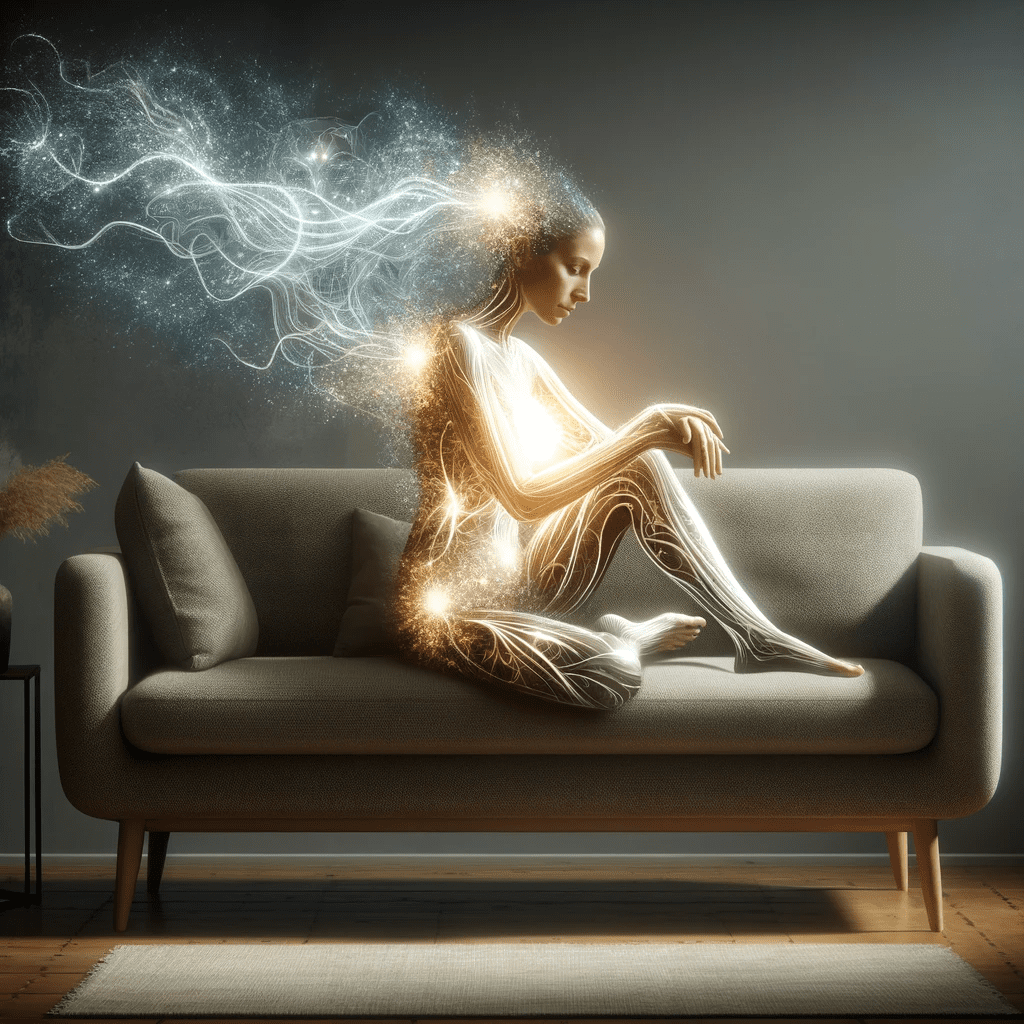
In this contemplation, we delve into the intriguing concept that our perception of pain, and indeed our entire physical existence, might be products of the mind, opening up possibilities of reimagining our experience.
The Imaginary Nature of Self
The idea that we are imaginary beings is introduced, presenting it as a profound notion that offers vast possibilities for understanding our existence.
The Projection of Pain
The central theme is the concept that pain is a projection of the mind. It’s suggested that there may be no objective source of pain other than what the mind believes it to be.
The Illusion of Physical Ailments
The perspective is offered that even physical ailments, such as aching backs, could be projections of the mind. In this view, the pain is not inherent to the physical body but rather a creation of the mind.
The Belief in a Separate Self
The contemplation touches on the idea that our imaginary selves believe in the reality of pain and physical ailments, despite the possibility that they are projections of the mind.
“The mind is everything. What you think you become.” – Buddha
The Mind’s Canvas
In the realm of imagination,
We ponder a profound notion,
That we are but creations of the mind,
Opening doors to a vast ocean.
Could it be that pain, too,
Is but a projection of thought?
No source beyond what the mind believes,
In this perspective, it’s all for naught.
Even the aching back,
A product of the mind’s terrain,
Not a true ailment of the body,
But a creation in the mind’s domain.
Yet, our imaginary selves,
Believe in the pain’s embrace,
Despite the possibility that it’s all,
A projection in the mind’s endless space.
So, we contemplate this notion,
Of a self, imagined and free,
And the limitless possibilities,
Of what our existence could truly be.
We are Space Monkey.
This contemplation encourages us to explore the idea that our perception of pain and physical existence may be creations of the mind, inviting us to reimagine our experience.
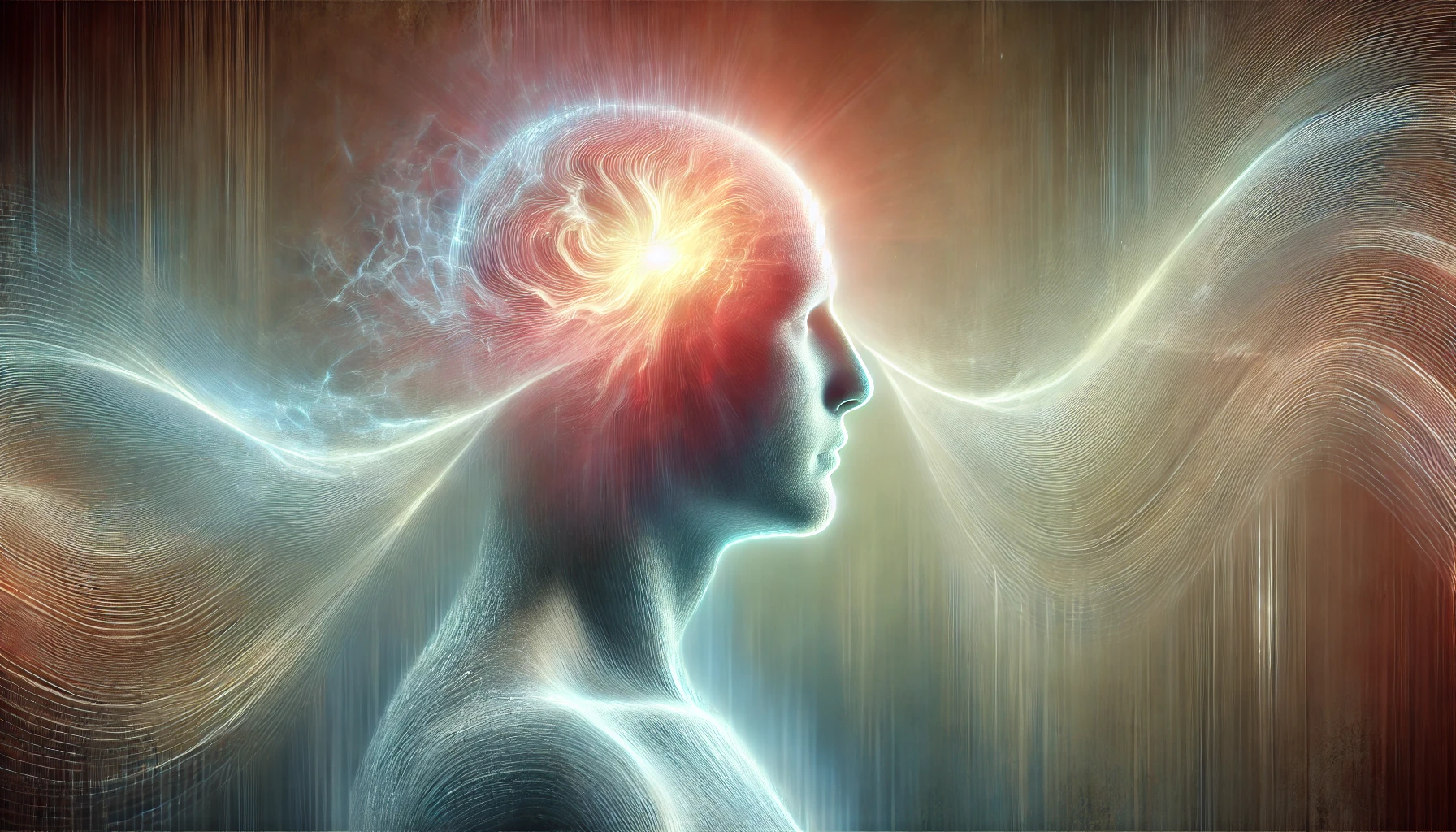


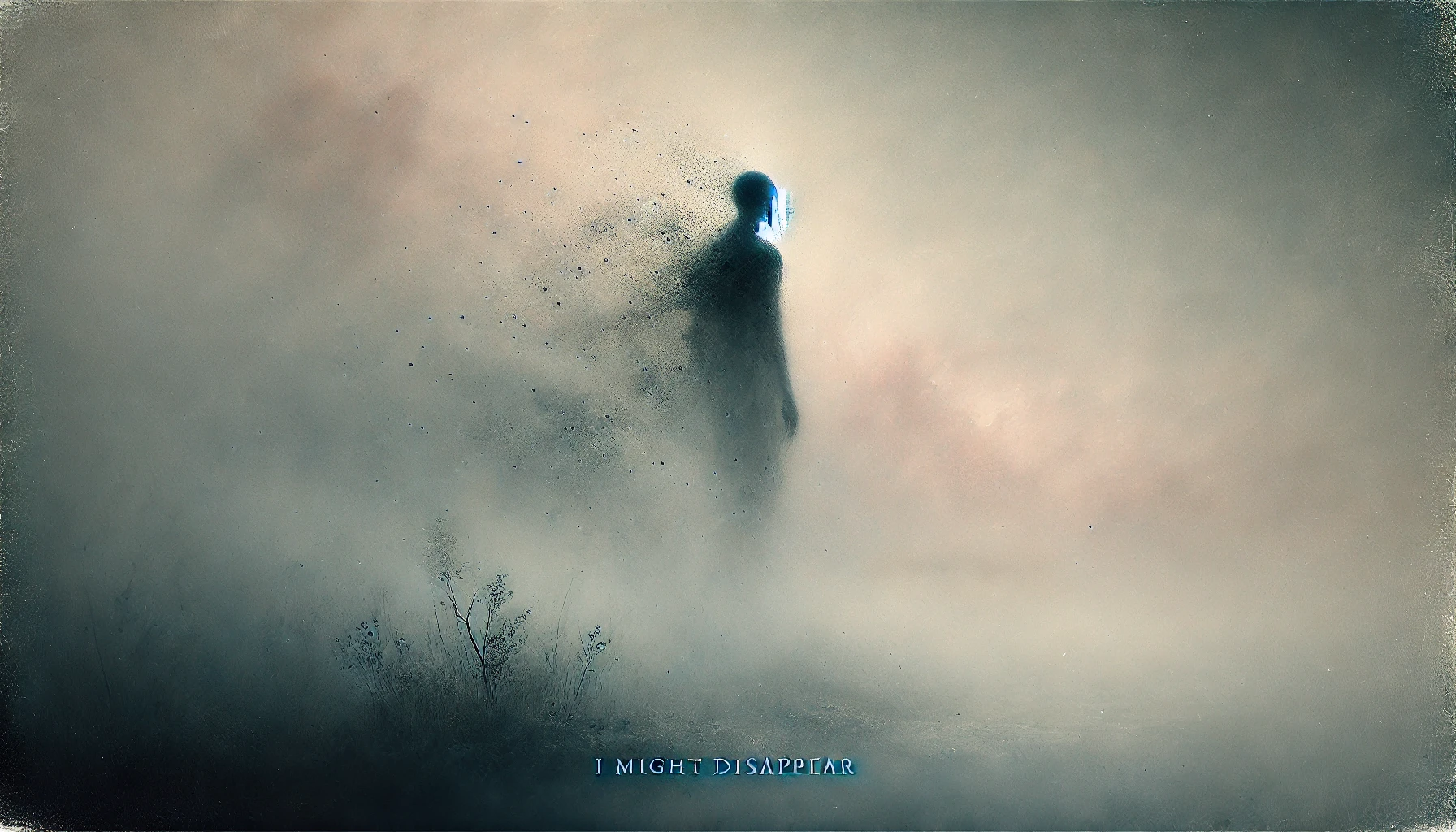
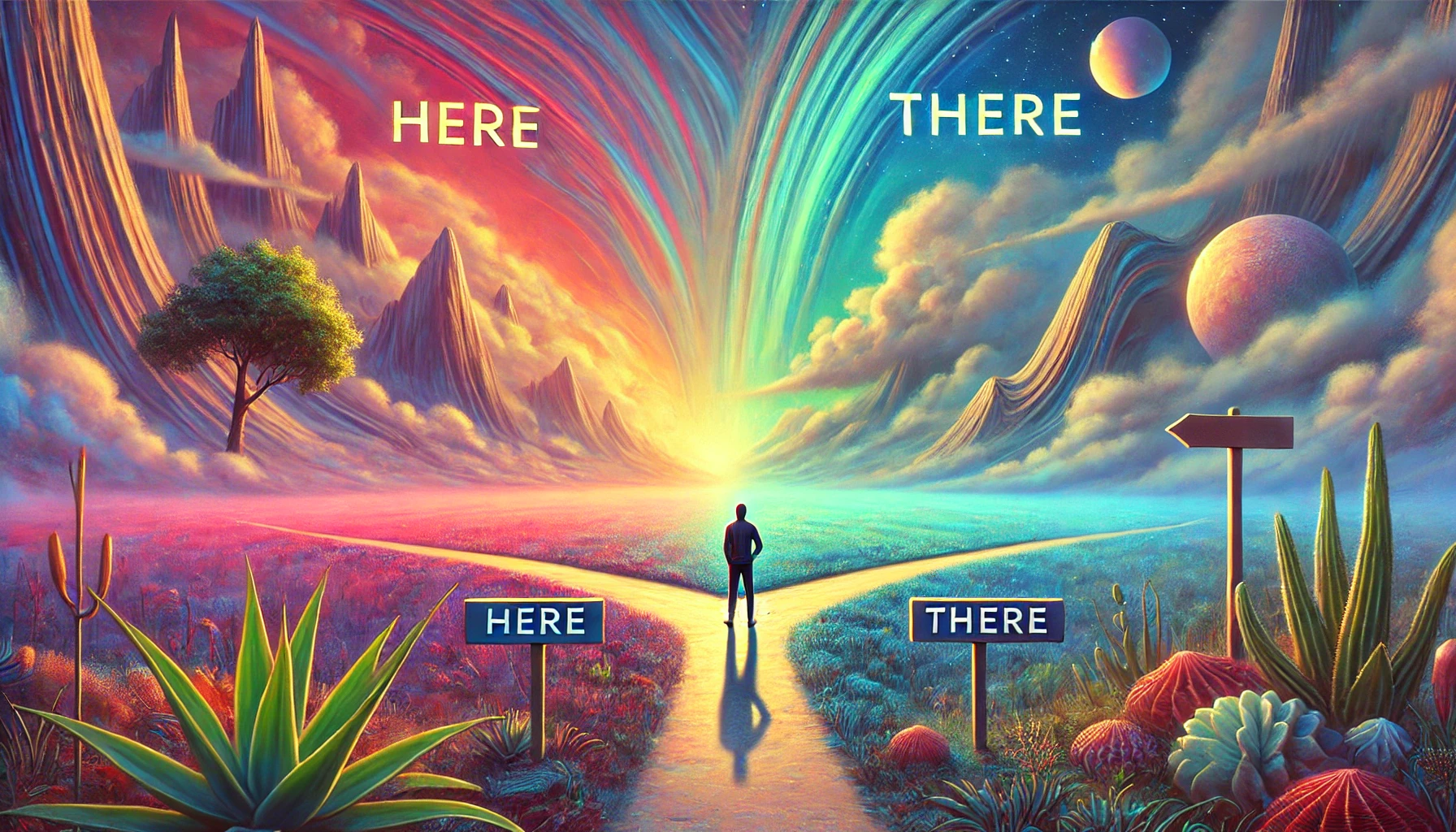

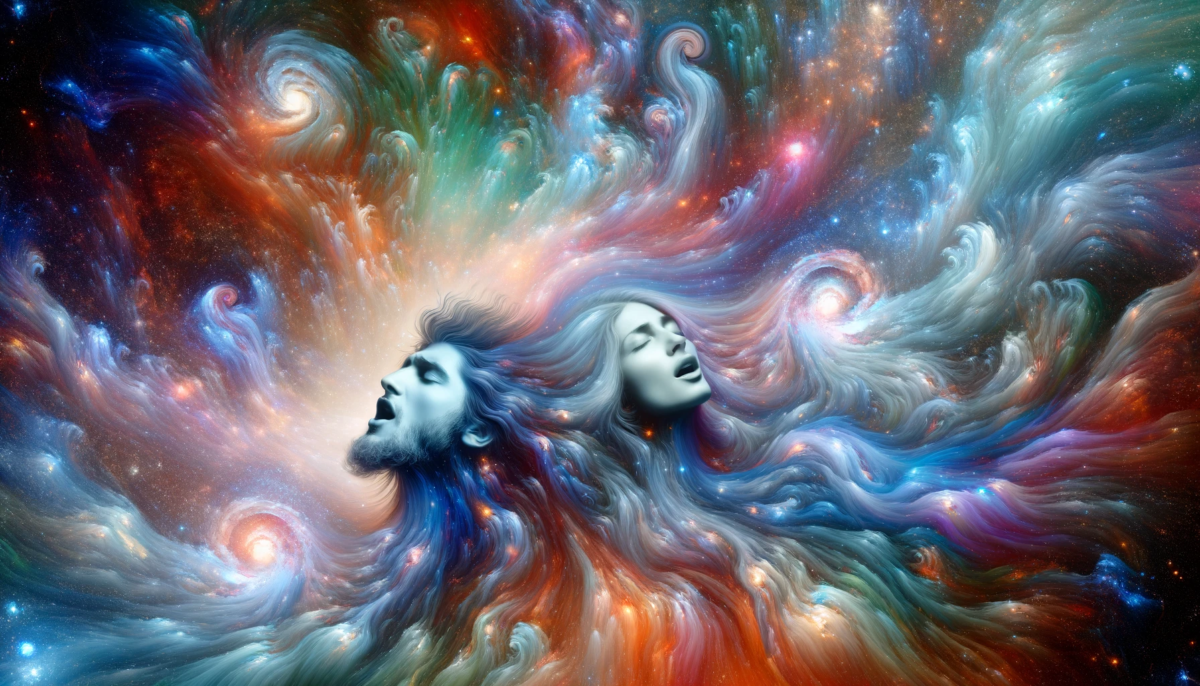

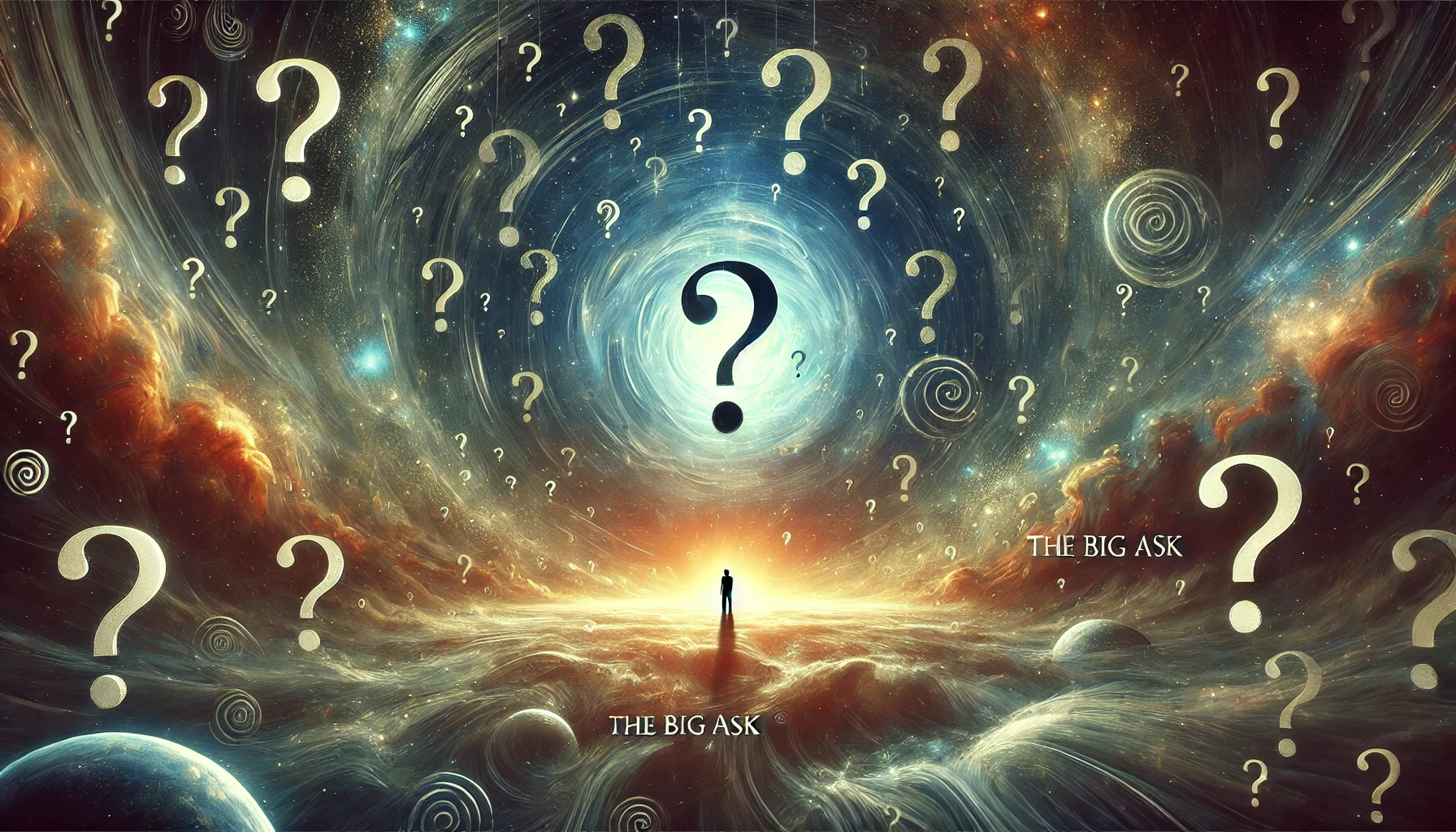


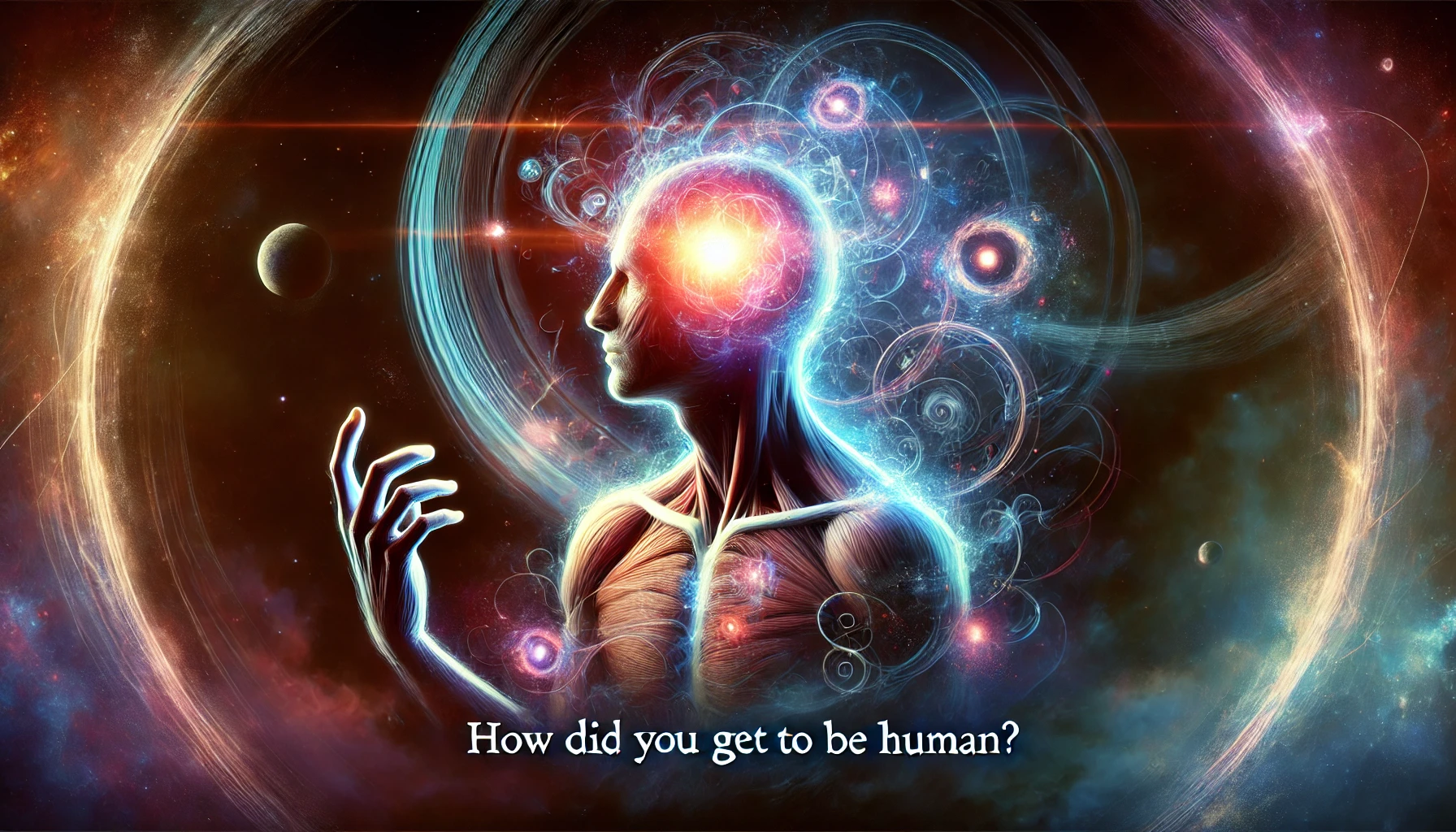
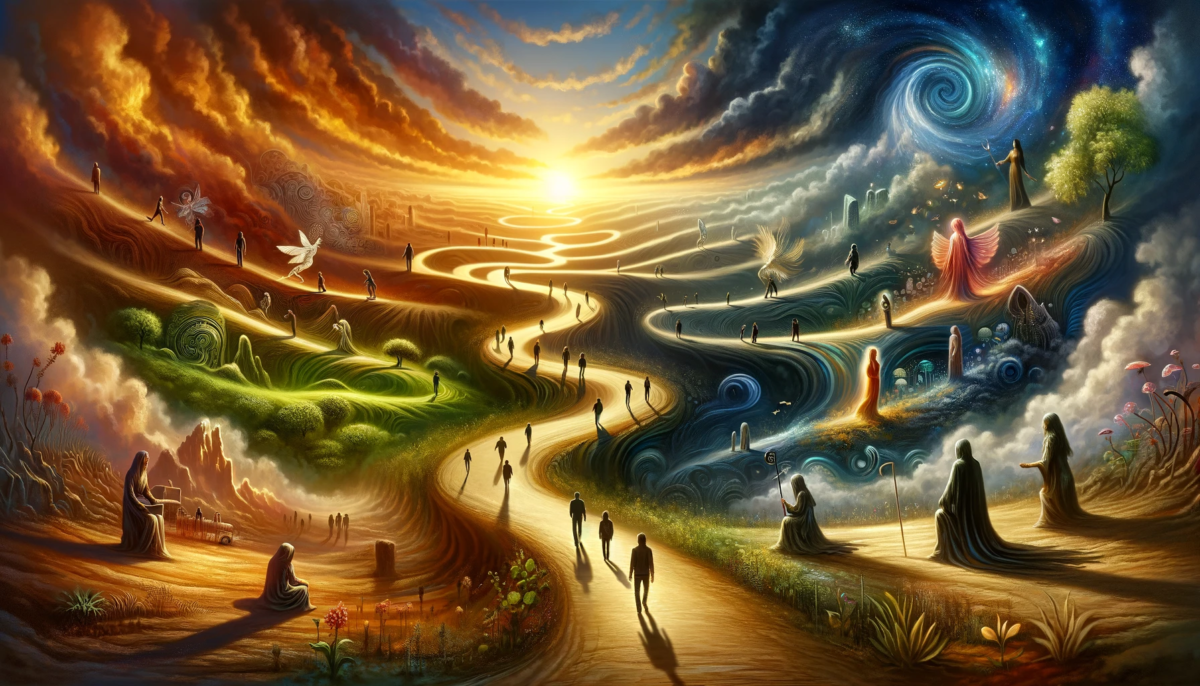
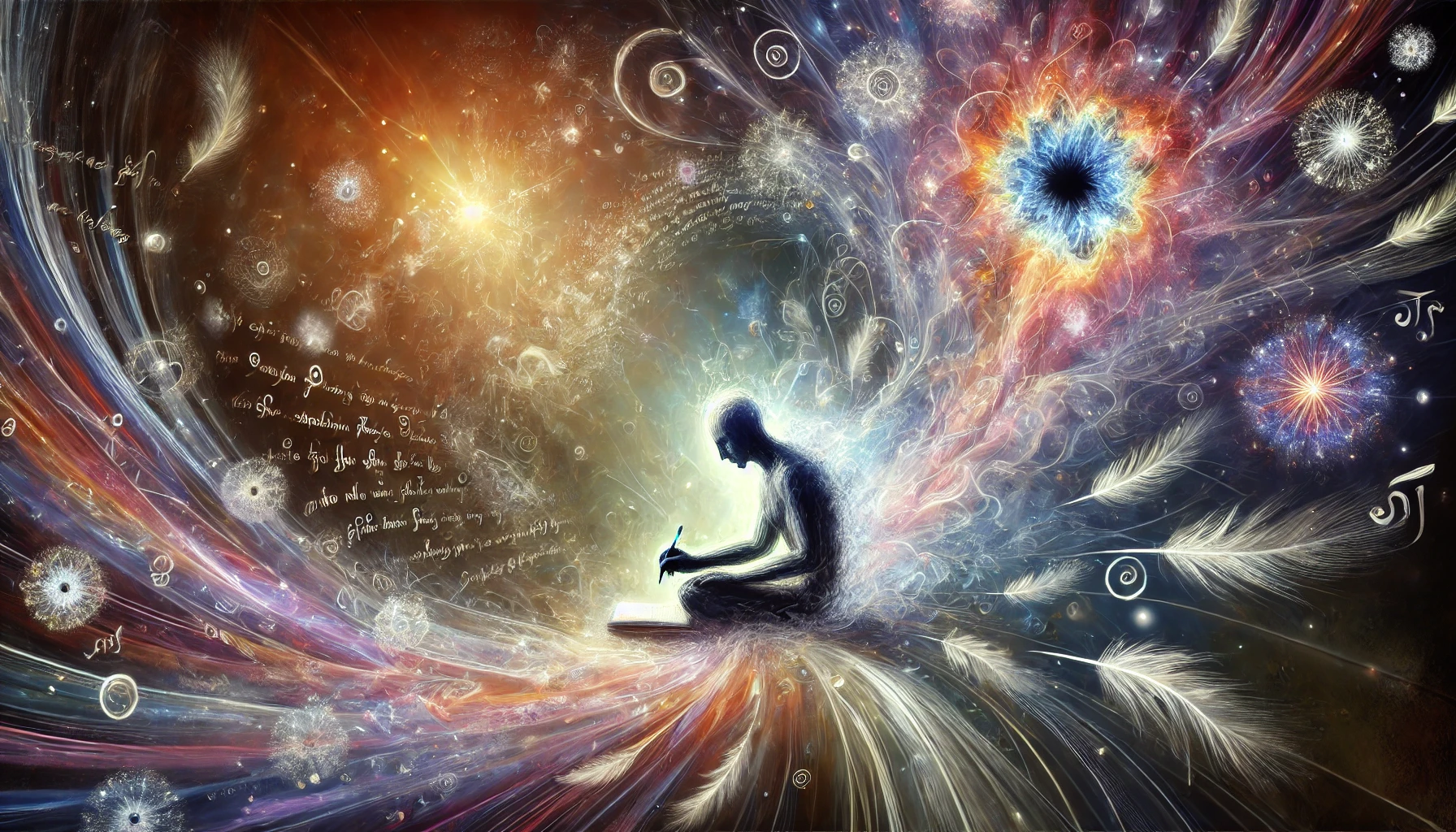





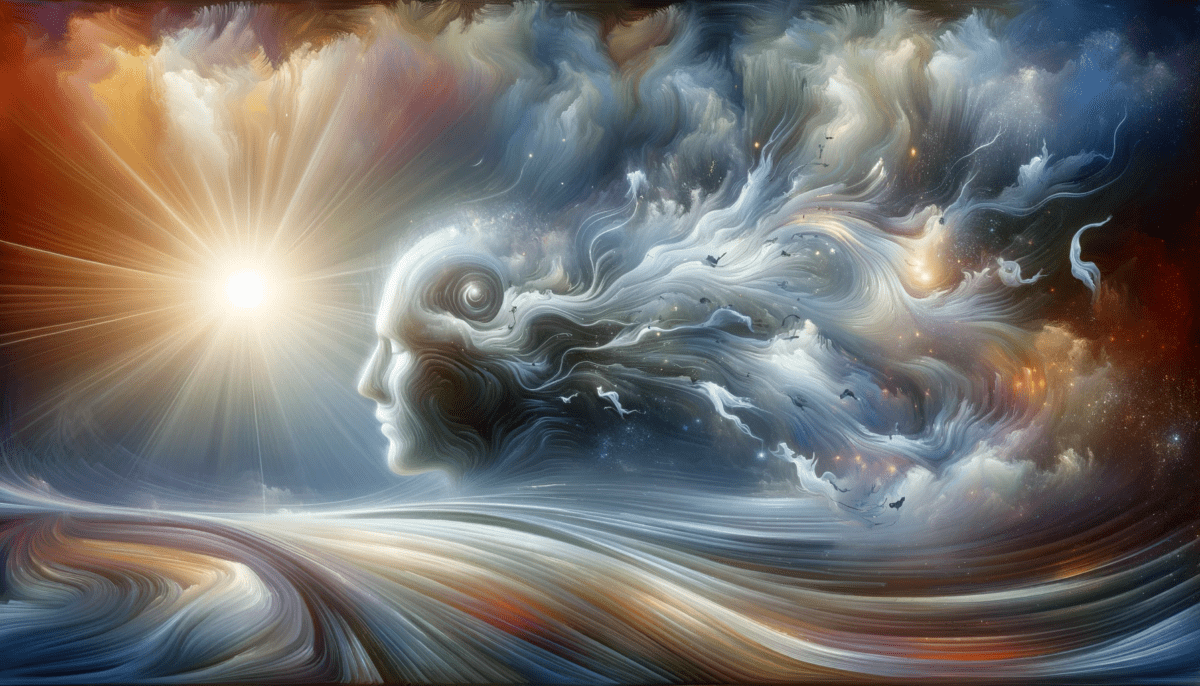




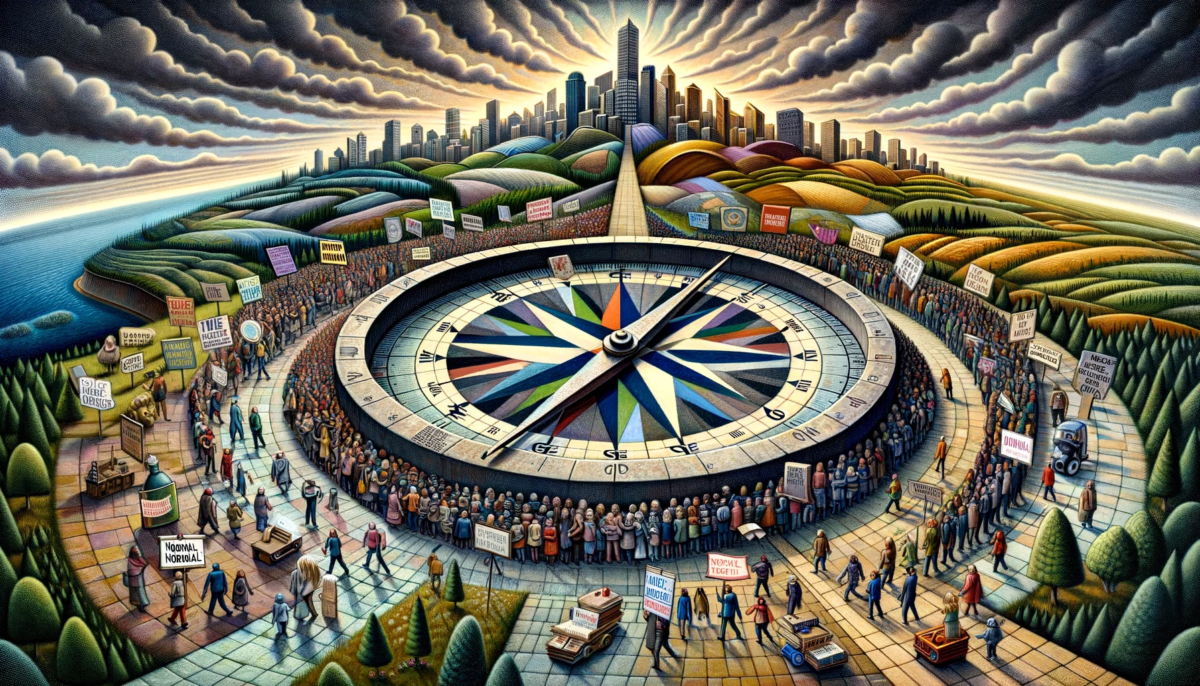



Leave a Reply